AN OVERVIEW OF THE KOREAN LANGUAGE AND KOREAN LANGUAGE EDUCATION
Abstract
Full Text:
1-9References
Eckardt, A. 1966. Koreanisch und Indogermanisch. Heidelberg: Julius Groos.
Hulbert, H. 1905. A Comparative Grammar of the Korean Language and the Dravidian Languages
of India. Seoul: Methodist Publishing House.
Kim, H.K. 1962. Gukeosa Yeongu (A Historical Study of Korean). Seoul: Iljogak.
Kim, H.K. 1972. Gukeohak Gaeron (An Introduction to Korean Linguistics). Seoul: Iljogak.
Koppelmann, H. 1933. Die Eurasische Sprachfamilie, Indogermanische, Koreanisch und
Verwandtes. Heidelberg: Winter.
Lee, I.S., S.O. Lee, and W. Chae. 1997. Hangukeui Eoneo (The Language of Korea). Seoul:
Singumunhwasa.
Lee, K.B. 1984. A New History of Korea (translated by E.W. Wagner with E.J. Shultz). Cambridge,
Mass.: Harvard University Press.
Lee, K.M. 1976. Gaejeong Gukeosa Gaeseol (A Revised Introduction to the History of Korean).
Seoul: Minjungseogwan.
Martin, S. 1966. Lexical evidence relating Korean to Japanese, Language 42, 185-251.
Miller, R. 1971. Japanese and the other Altaic Languages. Chicago: University of Chicago Press.
Miller, R. 1976. The relevance of historical linguistics for Japanese studies, Journal of Japanese
Studies 2-2, 335-388.
Miller, R. 1979. Some old Baekje fragments, Journal of Korean Studies 1, 3-69.
Nahm, A. 1993. Introduction to Korean History and Culture. Seoul: Hollym.
Park, Y.S. 2008. Hangeul and Korean language education, in J.S. Hong (ed.), Hangeul in The
World. Seoul: Pagijong Press.
Pei, M. 1954. The World’s Chief Languages. London: George Allen and Urwin.
Pinker, S. 2003. The Language Instinct: How the mind creates language. London: Penguin Books.
Polivanov, E. 1927. K voprosu o rodstvennyx otnosenijax korejskogo i ‘altajskix’ jazykov (On the
issue of the genetic relationship of Korean and Altaic languages), Izvestja Akademia Nauk,
SSSR, Ser. VI, XXI, 15-17, 1195-1204. Moscow.
Poppe, N. 1960. Vergleichende Grammatik der altaischen Sprachen, Teil 1, Vergleichende
Lautlehre. Wiesbaden: Otto Harrassowitz.
Rahder, J. 1956. Etymological vocabulary of Chinese, Korean, and Ainu I, Monumenta Nipponica
Monograph 16 (Tokyo), 1959-1969. II and III, Journal of Asiatic Studies 2-1 and 2-2 (Seoul),
IV, Orbis 10-1 (Louvain).
Ramstedt, G. 1928. Remarks on the Korean language, Mémories de la Société Finno-Ougrienne
Helsinki.
Ramstedt, G. 1949. Studies in Korean Etymology. Helsinki: Suomalais-Ugrilainen Seura.
Ramstedt, G. 1952. Einführung in die altaische Sprachwissenschaft I, Lautlehre. Mémoires de la
Société Finno-Ougrienne 104-1. Helsinki.
Ramstedt, G. 1957. Einführung in die altaische Sprachwissenschaft Ⅱ, Formenlehre. Mémoires de
la Société Finno-Ougrienne 104-2. Helsinki.
Shiratori, K. 1914-6. Chosengo to Ural-Altai-go to no hikaku kenkyu (A comparative study of
Korean and Ural-Altaic languages). Reprinted in Shiratori Kurakichi Zenshu 3. Tokyo: Iwanami
Shoten (1970).
Sohn, H.M. 1999. The Korean Language. Cambridge: Cambridge University Press.
Street, J. 1974. On the Lexicon of Proto-Altaic: a Partial Index to Reconstructions. Madison, Wis.:
author.
http://khnews.kheraldm.com/view.php?ud=20170403000219&md=20170812011418_BL
http://www.korean.go.kr/front_eng/edu/edu_01.do
http://www.korean.go.kr/front_eng/edu/edu_02.do
Article Metrics
Abstract view : 2257 times1-9 - 1297 times
Refbacks
- There are currently no refbacks.
